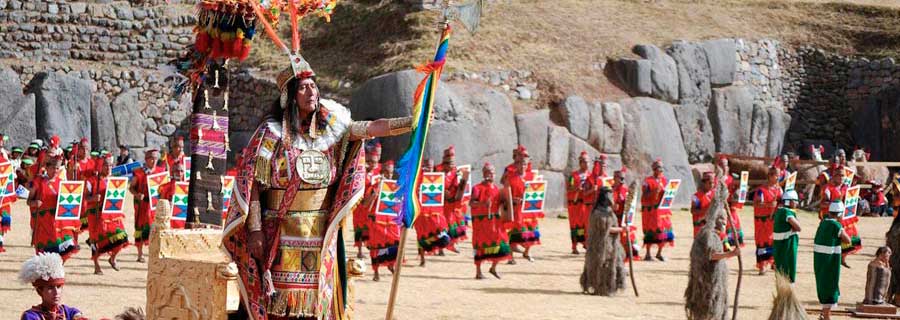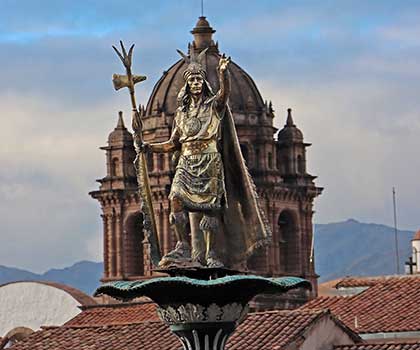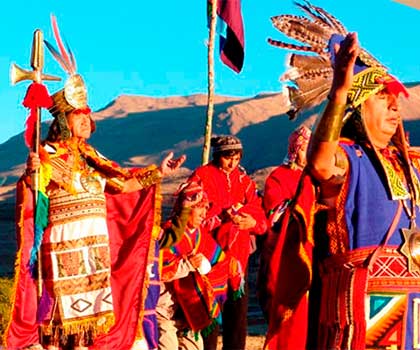History of the Sacred Valley
In Quechua it is known as Vilcamayo, and in Spanish El Valle Sagrado de los Incas. This fertile valley, which has been irrigated by the Urubamba River stretches from Pisac to Ollantaytambo. There is a settlement history going as far back as 800 B.C. with the Chanapata civilization. Great opportunities were given to the local cultures due to some of the best agriculture in the region. As the early tribes of Peru changed over from a nomadic society of hunters to a society of farmers who soon settled, the Sacred Valley was key to the pre-Columbian Peru's development.
Some other pre-Incan civilizations that followed later on included the Qotacalla, who lived from 500 to 900 A.D., with the Killke continuing until the Incan domination of the region in 1420. This last civilization lasted until the arrival of the Spaniards one hundred years later.
The valley itself was indeed regarded as sacred by the Incas, the territorial correlation to the Milky Way. Their mythology had the founding fathers of the region, the Ayar Brothers, as emerging from the Ollantaytambo pyramid.

Ollantaytambo actually served as the battleground for one of the last successful defeats of the Spanish army. The famous Manco Inca withdrew from Cusco and his forces redirected the Río Patacancha to keep Pizarro's soldiers away. During this time, he enlisted forces from the jungle tribes to help support the troops against the Spanish. Pizarro did retreat, but eventually returned with reinforcements.
Ironically, despite the subsequent attempt to remake the region and its people under Spain, much of the culture has remained unchanged throughout the centuries. People still speak Quechua, and farming methods are still very basic.
Incan Culture
The civilization of the Incas began as a tribe founded in the Cusco area where the legendary first Sapa Inca, Manco Capac founded the Kingdom of Cusco around 1200 AD. The area and the state grew as other Andean communites began to play a role in the expansion of the region. In 1442, the Incas were flourishing, namely under the command of Pachacutec, who name literally meant “earth-shaker”. It was he who formed the Inca Empire of Tawantinsuyu which would soon become the largest empire to ever reigh in pre-Columbian America.
During this time, the Empire suffered a civil war between two brothers, Huascar and Atahualpa. As the Spanish conquerors soon began to seep their way into the land, they took advantage of this civil war and conquered the Inca territory in 1533. Little by little, the conquistadors managed to take over power for the entire Andean region. Sadly in 1572, the fall of the last Incas and their resistance ended at the battle of Vilcabamba. It is beautiful to see how the people of Peru have kept some of the cultural traditions in some ethnic groups such as the Quechuas and Aymara people.
Ollantay's Myth
The beautiful myth of Ollantay is still told today. The Incas had many myths and stories that have last over the centuries and can still be seen in the hearts of the people and of the culture today in the Sacred Valley. The story goes that the princess Cusi Coyllur (Inca Pachacutec's daughter), secretly married a remarkable general named Ollantay (a Privileged Noble).
Time passed and Ollantay finally dared to formally and publicly ask for the hand of Cusi Coyllur (Happy Star in Quechua). Inca Pachacutec, in response, locked his daughter away in the Acllawasi (similar to a Convent), keeping Ollantay far away from her for the Emperor did not consider the general worthy of being Cusi Coyllur's husband, due to his origin.
In response, Ollantay lead his followers to a fortress later known as Ollantay Tambo, in the Urubamba Valley, to oppose the Inca. When Pachacutec learned about this, he sent Rumi Ñahui (Stone Eye in Quechua) to fight and defeat him. He could not prevail due to Ollantay's fierce resistance, lasting almost ten years. During that time, Cusi Coyllur gave birth to Ollantay's daughter, Imac Sumac.
As time passed and the Inca Pachacutec died, Rumi Ñahui realized finally that he had been beaten by Ollantay and devised a plan. Pretending he had been degraded, he ordered to be punished for his continuing lack of success. Rumi Ñahui decided to use the Inti Raymi festivities to get as close as possible to his enemy. Feigning shame and fear, he begged an overconfident Ollantay for help and was welcomed. Rumi Ñahui had already planned for Ollantay's soldiers to end up drunk and disoriented, therefore helping him follow through with his scheming plan. When the time was right during the celebration, he sprung his trap and took Ollantay prisoner.
Ollantay and Cusi Coyllur were taken to the new Inca, Tupac Yupanqui, who listened to the story of Ollantay's sister and father. In desperation, Imac Sumac appeared and interceded on her mother's behalf. After listening to those arguments, Tupac Yupanqui allowed Cusi Coyllur and Ollantay's marriage to be officially sanctioned.


Inca Religion
Pachacuti was a key influence on the drastic reorganization of the Inca religion. He claimed to be the direct descendant of the Inca Sun God Inti, which brought strict obedience from his people. Their daily work tasks almost became a religious duty as Pachacuti created a cult around himself and the sun-god Inti.
Every day the emperor would wear new clothes and have his old ones from the previous day burned. Meals would only be eaten from his golden plates. He believed himself to be an actual god.
Inca society was a theocratic society, meaning that politics and religion were completely intertwined. The Inca religion combined many features of animism, fetishism, and the worship of nature gods representing forces of nature. Through these rituals, the Incas practiced forms of divination and the sacrifice of humans and animals.
Society, Economy and Politics
Pachacuti and his son Topa Inca managed to take over these vastly different regions, inhabited by over 100 different tribes of people into a political union that could feed and clothe millions of people, carry out tremendous construction programs, and supply large armies. He called his new kingdom Cuzco, and soon introduced an ingenious system of government, social system, economy and religion. He was one of the most powerful rules that ever existed in world history. He did not depend on a council of advisors, but made all the decisions for his people alone.
The Inca emperor Pachacuti appointed himself as a holy emperor and claimed that he was the direct descendant of the creator god Pachacamac (also called Viracocha). Under his rule, Cuzco became a 'huaca', or holy place, dedicated to the sun god Inti. Pachacuti destroyed the old adobe structures and had the entire city rebuilt in stone. On the south-end of town he built a temple dedicated to both the sun and to himself. The walls were covered with vast quantities of gold.
One of the problems that the government had was the redistribution of food and clothing. The corn, potatoes and cotton needed by millions of people were all produced in different areas of the empire. The Inca people solved this by developing a form of practical socialism. Each village produced what its ecosystem would allow and gave its surpluses to other villages in different areas. In return, poorer villages farming in the mountain terrain less fertile would then receive the products that they could not grow themselves. Some of the surplus was stored to feed soldiers or labor crews that were building temples or roads. This system is called reciprocity and is the reason why the Inca did not have markets. Everybody supplied and received the necessities of life through this system of reciprocity.